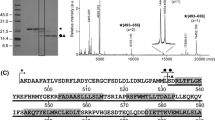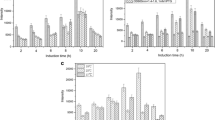Abstract
Licorice is gaining popularity because of its significant biological anti-inflammatory activity, while CC chemokine receptor 4 (CCR4) has been identified as a potentially important drug target for the treatment of inflammatory diseases. Capillary electrophoresis was developed for screening for the first time of CCR4 antagonists from natural products of licorice. The interactions between natural products of licorice and ML40, the equivalent peptide derived from the N-terminal of CCR4, were determined. Twenty-eight ingredients were isolated and the results showed that ten of them interacted with ML40 compared with the positive control S009. The binding constants of the compounds to ML40 were calculated and the binding constant of liquiritin apioside (LA) was the largest among them (3.636 ± 0.2185) × 104 M−1. The CCR4 antagonisms of the compounds that showed strong integration with ML40 were also confirmed by chemotaxis inhibition in which they displayed different degrees of inhibition to CCL22/CCL17-induced HEK293 chemotaxis. The methodology presented could be applied to automated high-throughput screening of potential antagonists of CCR4. This study provided the potential rationale for the development of anti-inflammatory compounds from natural products of licorice.



Similar content being viewed by others
References
Wells TN, Power CA, Shaw JP, Proudfoot AE (2006) Chemokine blockers—therapeutics in the making? Trends Pharmacol Sci 27:41–47
Ledee N, Lombroso R, Lombardelli L, Selva J, Dubanchet S, Chaouat G, Frankenne F, Foidart JM, Maggi E, Romagnani S, Ville Y, Piccinni MP (2008) Cytokines and chemokines in follicular fluids and potential of the corresponding embryo: the role of granulocyte colony-stimulating factor. Hum Reprod 23:2001–2009
Purandare AV, Wan H, Somerville JE, Burke C, Vaccaro W, Yang X, McIntyre KW, Poss MA (2007) Core exploration in optimization of chemokine receptor CCR4 antagonists. Bioorg Med Chem Lett 17:679–682
Wang Y, Zhang YM, Yang X, Han WL, Liu Y, Xu Q, Zhao R, Di C, Song Q, Ma DL (2006) Chemokine-like factor 1 is a functional ligand for CC chemokine receptor 4 (CCR4). Life Sci 78:614–621
Newhouse B, Allen S, Fauber B, Anderson AS, Eary CT, Hansen JD, Schiro J, Gaudino JJ, Laird E, Chantry D, Eberhardt C, Burgess LE (2004) Racemic and chiral lactams as potent, selective and functionally active CCR4 antagonists. Bioorg Med Chem Lett 14:5537–5542
Gozansky EK, Louis JM, Caffrey M, Clore GM (2005) Mapping the binding of the N-terminal extracellular tail of the CXCR4 receptor to stromal cell-derived factor-1alpha. J Mol Biol 345:651–658
Hu K, Zhang LC, Li XT, Zhao SL (2010) Rapid screening of monoamine oxidase B inhibitors in natural extracts by capillary electrophoresis after enzymatic reaction at capillary inlet. J Chromatogr B 878:3156–3160
Wang YC, Yang YS (2007) Simultaneous quantification of flavonoids and triterpenoids in licorice using HPLC. J Chromatogr B 850:392–399
Zhang QY, Ye M (2009) Chemical analysis of the Chinese herbal medicine Gan-Cao (licorice). J Chromatogr A 1216:1954–1969
Asl MN, Hosseinzadeh H (2008) Review of pharmacological effects of Glycyrrhiza sp. and its bioactive compounds. Phytother Res 22:709–724
Jayaprakasam B, Doddaga S, Wang R, Holmes D, Goldfarb J, Li XM (2009) Licorice flavonoids inhibit eotaxin-1 secretion by human fetal lung fibroblasts in vitro. J Agric Food Chem 57:820–825
Xie YC, Dong XW, Wu XM, Yan XF, Xie QM (2009) Inhibitory effects of flavonoids extracted from licorice on lipopolysaccharide-induced acute pulmonary inflammation in mice. Int Immunopharmacol 9:194–200
Kolbe L, Immeyer J, Batzer J, Wensorra U, tom Dieck K, Mundt C, Wolber R, Stab F, Schonrock U, Ceilley RI, Wenck H (2006) Anti-inflammatory efficacy of licochalcone A: correlation of clinical potency and in vitro effects. Arch Dermatol Res 298:23–30
He XY, Ding YS, Li DZ, Lin BS (2004) Recent advances in the study of biomolecular interactions by capillary electrophoresis. Electrophoresis 25:697–711
Rabanes HR, Guidote AM Jr, Quirino JP (2012) Capillary electrophoresis of natural products: highlights of the last five years (2006–2010). Electrophoresis 33:180–195
Li B, Lv XF, Qing H, Geng LN, Deng YL (2011) Monoamine oxidase inhibitor screening by proteoliposome capillary electrophoresis. Chromatographia 74:619–624
Tseng HM, Li Y, Barrett DA (2010) Bioanalytical applications of capillary electrophoresis with laser-induced native fluorescence detection. Bioanalysis 2:1641–1653
Castro-Puyana M, Garcia-Canas V, Simo C, Cifuentes A (2012) Recent advances in the application of capillary electromigration methods for food analysis and Foodomics. Electrophoresis 33:147–167
Liu X, Dahdouh F, Salgado M, Gomez FA (2009) Recent advances in affinity capillary electrophoresis (2007). J Pharm Sci 98:394–410
Liao J, Pan YJ, Li CC, Wen DW, Liu HW (2011) Fast screening for tobacco-specific N-nitrosamines by CZE using dynamically coated capillaries. Chromatographia 74:415–419
Zhang SY, Qi H, Yakufu P, Zhao F, Ling XM, Xiao JH, Wang Y (2011) Screening of thiourea derivatives and carbonyl-2-aminothiazole derivatives for potential CCR4 antagonists using capillary zone electrophoresis. J Chromatogr B 879:75–82
Austin C, Pettit SN, Magnolo SK, Sanvoisin J, Chen W, Wood SP, Freeman LD, Pengelly RJ, Hughes DE (2012) Fragment screening using capillary electrophoresis (CEfrag) for hit identification of heat shock protein 90 ATPase inhibitors. J Biomol Screen 17:868–876
El-Hady D, Kuhne S, El-Maali N, Watzig H (2010) Precision in affinity capillary electrophoresis for drug–protein binding studies. J Pharm Biomed Anal 52:232–241
Scatchard G (1949) Equilibrium in non-electrolyte mixtures. Chem Rev 44:7–35
Azad M, Kaddis J, Villareal V, Hernandez L, Silverio C, Gomez FA (2004) Affinity capillary electrophoresis to examine receptor–ligand interactions. Methods Mol Biol 276:153–168
Tunon MJ, Garcia-Mediavilla MV, Sanchez-Campos S, Gonzalez-Gallego J (2009) Potential of flavonoids as anti-inflammatory agents: modulation of pro-inflammatory gene expression and signal transduction pathways. Curr Drug Metab 10:256–271
Lee JY, Lee JH, Park JH, Kim SY, Choi JY, Lee SH, Kim YS, Kang SS, Jang EC, Han Y (2009) Liquiritigenin, a licorice flavonoid, helps mice resist disseminated candidiasis due to Candida albicans by Th1 immune response, whereas liquiritin, its glycoside form, does not. Int Immunopharmacol 9:632–638
Liu B, Yang J, Wen QS, Li Y (2008) Isoliquiritigenin, a flavonoid from licorice, relaxes guinea-pig tracheal smooth muscle in vitro and in vivo: role of cGMP/PKG pathway. Eur J Med Chem 587:257–266
Heim KE, Tagliaferro AR, Bobilya DJ (2002) Flavonoid antioxidants: chemistry, metabolism and structure-activity relationships. J Nutr Biochem 13:572–584
Zhao F, Xiao JH, Wang Y, Li S (2009) Synthesis of thiourea derivatives as CCR4 antagonists. Chin Chem Lett 20:296–299
Sun Z, Ling XM, Sun W, Xiao JH, Yin C, Wang Y (2007) Studies on the interactions between lactam analogs and the N-terminal extracellular tail of CC chemokine receptor 4 by CZE. Electrophoresis 28:3064–3069
Acknowledgments
We thank Professor Dalong Ma for his unconditional support. This work was financially supported by the National Natural Science Foundation (30872292, 90813025 and 81072612), the Natural Science Foundation of Beijing (7102107), the Foundation of State Key Laboratory of Natural and Biomimetic Drugs (K2012004) and Specialized Research Fund for the Doctoral Program of Higher Education of China (20110001110021).
Author information
Authors and Affiliations
Corresponding authors
Rights and permissions
About this article
Cite this article
Li, M., Wang, Q., Ling, X. et al. Interactions Between N-Terminal Extracellular Tail of CCR4 and Natural Products of Licorice Using Capillary Electrophoresis. Chromatographia 76, 811–819 (2013). https://doi.org/10.1007/s10337-013-2474-y
Received:
Revised:
Accepted:
Published:
Issue Date:
DOI: https://doi.org/10.1007/s10337-013-2474-y




